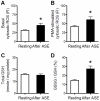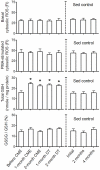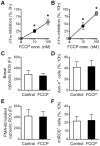Severe exercise and exercise training exert opposite effects on human neutrophil apoptosis via altering the redox status
- PMID: 21931703
- PMCID: PMC3170310
- DOI: 10.1371/journal.pone.0024385
Severe exercise and exercise training exert opposite effects on human neutrophil apoptosis via altering the redox status
Abstract
Neutrophil spontaneous apoptosis, a process crucial for immune regulation, is mainly controlled by alterations in reactive oxygen species (ROS) and mitochondria integrity. Exercise has been proposed to be a physiological way to modulate immunity; while acute severe exercise (ASE) usually impedes immunity, chronic moderate exercise (CME) improves it. This study aimed to investigate whether and how ASE and CME oppositely regulate human neutrophil apoptosis. Thirteen sedentary young males underwent an initial ASE and were subsequently divided into exercise and control groups. The exercise group (n = 8) underwent 2 months of CME followed by 2 months of detraining. Additional ASE paradigms were performed at the end of each month. Neutrophils were isolated from blood specimens drawn at rest and immediately after each ASE for assaying neutrophil spontaneous apoptosis (annexin-V binding on the outer surface) along with redox-related parameters and mitochondria-related parameters. Our results showed that i) the initial ASE immediately increased the oxidative stress (cytosolic ROS and glutathione oxidation), and sequentially accelerated the reduction of mitochondrial membrane potential, the surface binding of annexin-V, and the generation of mitochondrial ROS; ii) CME upregulated glutathione level, retarded spontaneous apoptosis and delayed mitochondria deterioration; iii) most effects of CME were unchanged after detraining; and iv) CME blocked ASE effects and this capability remained intact even after detraining. Furthermore, the ASE effects on neutrophil spontaneous apoptosis were mimicked by adding exogenous H(2)O(2), but not by suppressing mitochondrial membrane potential. In conclusion, while ASE induced an oxidative state and resulted in acceleration of human neutrophil apoptosis, CME delayed neutrophil apoptosis by maintaining a reduced state for long periods of time even after detraining.
Conflict of interest statement
Figures






References
-
- Brinkmann V, Reichard U, Goosmann C, Fauler B, Uhlemann Y, et al. Neutrophil extracellular traps kill bacteria. Science. 2004;303:1532–1535. - PubMed
-
- Donowitz GR, Maki DG, Crnich CJ, Pappas PG, Rolston KV. Infections in the neutropenic patient–new views of an old problem. Hematology Am Soc Hematol Educ Program. 2001;2001:113–139. - PubMed
-
- Rollet-Labelle E, Grange MJ, Elbim C, Marquetty C, Gougerot-Pocidalo MA, et al. Hydroxyl radical as a potential intracellular mediator of polymorphonuclear neutrophil apoptosis. Free Radic Biol Med. 1998;24:563–572. - PubMed

